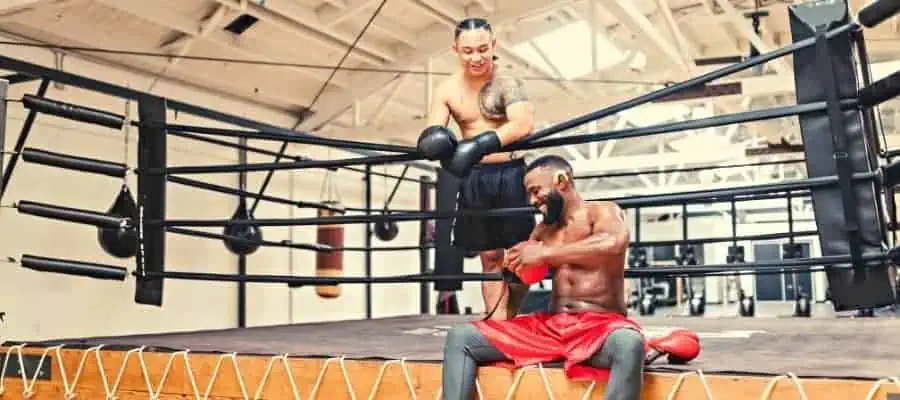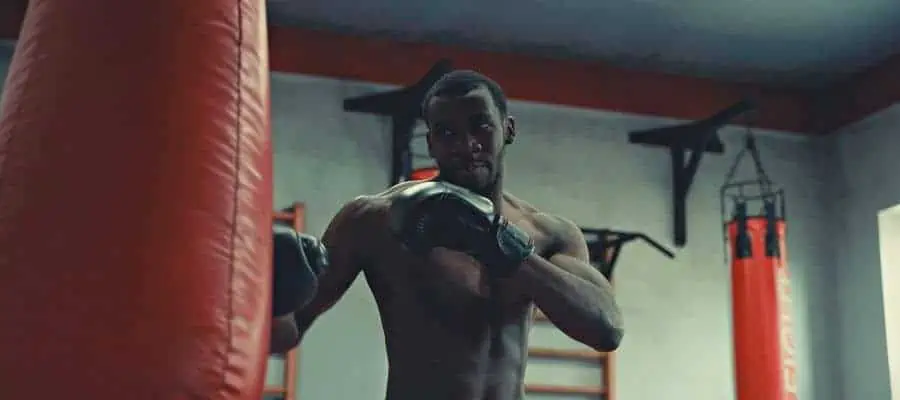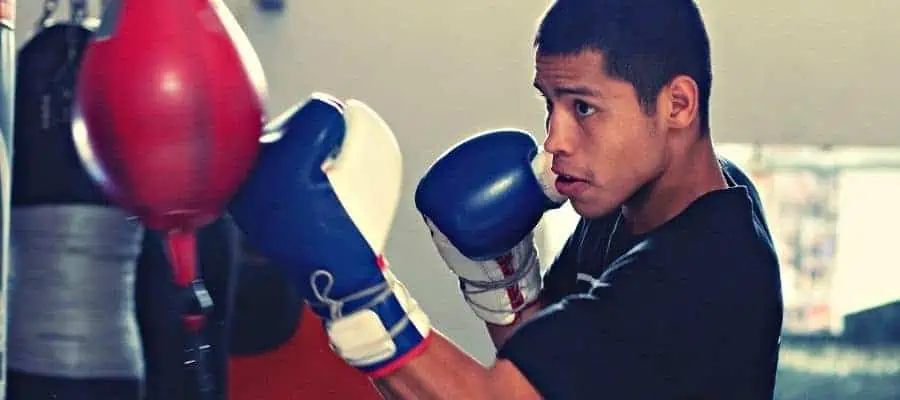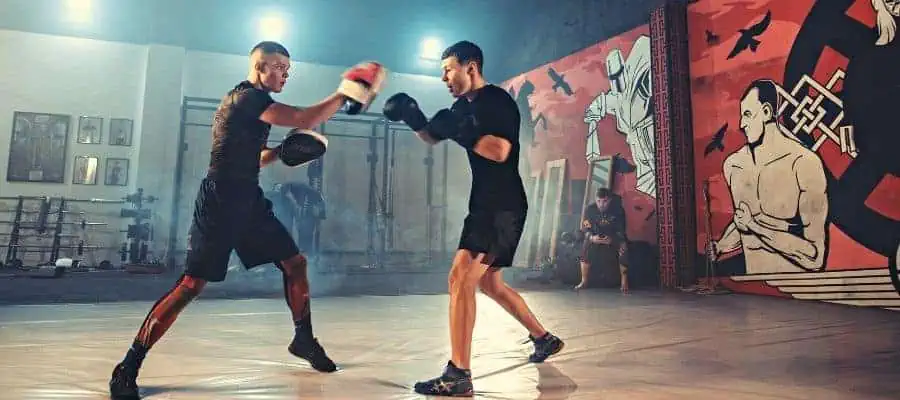All around the world, people endeavor on the road of the sport of boxing. One of the many reasons for this is because the training can be adapted to fit almost any purpose. The high-intensity, cardiovascular training is a great way to lose weight and build stamina.
However, while many people train for fun or as a way to keep fit, amateur and professional boxers step their training up a notch. You might wonder, how does this differ from your average shadowboxing, HIIT-based workout at your local gym?
So what does a boxer’s training schedule looks like? In general, this usually entails two to three training sessions a day. Nine out of ten times, a boxer will start their day off with roadwork or sprints to build stamina. The second session will then be dedicated to boxing. The focus will be on correcting techniques and building muscle memory. Professional boxers usually have more time than those fighting in the unpaid ranks. Often they can work in a third training session, which can focus on building strength or sparring.
However, we are only scratching the surface here. In modern times, boxers have a team of a coaching staff that includes a conditioning coach. Through years of development in how we train, new training ways have been formulated to receive the best results possible.
Basic Foundations Of Training In Amateur And Pro Boxing

The foundations of boxing can be classified into two groups. The first is the physical abilities of the boxer. The second one is the technical abilities of the boxer. Physical attributes refer to the three s’s – speed, strength, and stamina. On the other hand, a boxer’s technical fortitude refers to their technique or form, footwork, and ring IQ.
This is one of many training strategies that can be used to build a training program. Other examples of the basic programs include the distinction between offense and defense, or skill and strength. So splitting your workouts into physical and technical training has many benefits. It will allow you to optimize each workout and make the best progress.
This is because such a distinction allows you to focus on one particular thing at a time. It’s very hard to do training drills when your shoulders are burning because you’ve just finished lifting weights. In the same way, it becomes difficult to master new techniques when your heart is racing because of the HIIT workout you just did.
Also, each boxer should have a training schedule that fits his individual needs. People who box and have to go to work every day, may not be able to have as flexible a schedule as full-time professional boxers. Additional factors to consider include the resources available to these boxers. And also, how often they have the opportunity to do technical work.
The Physical Elements Of Boxing Training

There is no other sport like boxing. Two people decide to climb into a ring and take their bodies to the limit. With every punch damage is inflicted. You are breaking your opponent’s body down and you are burning energy at a frantic rate.
That is why stepping into the ring with a physical advantage will be of immense value. That is part of the reason why boxers put so much time and effort into working on their physical fitness.
Speed
Speed kills. It is a saying well-known and used all around the world. It is no less relevant in the context of combat sports, especially boxing. Take, for example, someone like Andy Ruiz. At first glance, you might not expect Andy to be such a threat. However, with lightning-fast hands, he caused chaos in the heavyweight division.
Boxers have various ways in which they focus on improving their hand speed. The most basic ways are through shadowboxing and bag work. In this context, the boxer must make a conscious focus on improving hand speed.
In the average training program, this will take the form of 5 x 3 mins rounds on the heavy bag or shadowboxing. Then the boxer mixes different combinations. He tries to throw as many punches as possible in a given time.
It’s not only a good cardiovascular workout, but it also builds the most important foundation of muscle memory. And this allows the boxer to use his hand speed as much as possible in a real boxing fight.
Further ways in which boxers improve on their hand speed is to do weighted shadow boxing.
Trying to perform punches with small dumbbells gets them used to resistance. When it’s time to throw punches, and the boxer can use the same energy without resistance, it means he improved his hand speed. The same principle applies to shadowboxing with resistance bands. In addition, boxers can use speed bags or double-end bags to develop their speed.
Strength
Every boxer wants to have that Anthony Joshua-type of knockout power. It is an extremely valuable weapon to have in your arsenal. It allows you to end fights with a mere few punches. Strength is also a very intricate topic. There are various theories about how to build strength.
On the one hand, lifting weights provide an attractive option to pursue as it allows one to build muscle. However, excessive weightlifting can often be counterintuitive. It is because it can cause boxers to slow down and lose their hand speed.
The key is then to maintain a balance. Ideally, a boxer wants to build a strong foundation in their compound lifts. Deadlifts, squats, bench, and military presses are important exercises. They can be done twice a week. Once you have the power, you need to be able to apply it.
Therefore, boxers must incorporate explosive exercises into their strength workouts. This includes exercises such as clapping push-ups, barbell press-outs, medicine ball throws, and landmine presses. Apart from the foundational strength exercises, for any additional exercises, a high rep scheme would be ideal. This builds endurance and allows the boxer to apply their power for a longer period.
Stamina
Stamina is most likely one of the most important aspects of a boxer’s training routine. If you lack stamina, then by the third round it won’t matter if you have all the power or hand speed in the world. It is also true that when someone becomes tired, they lose focus.
If you are tired, and for a single moment forget to keep your guard up, you might get caught with that big overhand right and you will wake up much later. As important as it is, stamina is also quite simple to work on. In general, you need to push yourself to your limits.
The most common exercise to build stamina is roadwork. Roadwork can be divided into two parts. The first one is to jog longer distances and the second one is to do sprints. Jogging for long distances allows you to build the necessary long capacity. This you will need to last all the rounds.
That is why most boxers run at least 5 times a week. The jogging can be supplemented with sprints. You can do whether short or long sprints on normal ground or uphill. These sprints can be very effective. It simulates what a real boxing fight looks like, as you often also need to have short bursts of energy in the fight.
It is also of cardinal importance to ensure that you build muscle endurance. That is why the high rep scheme for strength training is so important. Luckily, the answer is again very simple. After you have had your technical session of sparring or drills, finish your workout off with a few rounds on the bag.
At first, it will allow you to build muscle memory. Also, it will ensure that your shoulders do not start burning too soon during your next fight.
The Technical Elements Of Boxing Training

Technique
Good technique is what sets boxers apart. It applies in both offense and defense, in the way you punch as well as the way you slip or block the attack. In this regard, one would usually need the help of a coach. Therefore, you will learn the new techniques and drills either during pad work with a coach or during other specific exercises.
One example that we can refer to is how Canelo Alvarez, trains with his coach, Eddy Reynoso. During media workouts, we often see them working on specific combinations on the pads. There Eddy combines both offense and defense strategies into one.
They also make use of drills using a pool noodle, where Eddy attempts to hit Canelo with it. Here Canelo improves his head movement. Further technical drills can take a very simple form. You might want to practice throwing one-two punches, stepping back, and then countering with a straight followed by a left hook.
This is only one example of many combinations that can be used. One can work on mastering this technique through shadowboxing or bag work. It will make your body accustomed to the movements, as you continue to add speed and power.
Footwork
Good footwork is of critical importance to every boxer. It forms the absolute foundation of your offense and defense. It sets you up for punches, allows you to close or keep the distance, and most importantly, keeps you out of harm’s way.
That is why the one thing boxers are known for apart from running, is rope skipping. A quick warm-up on the skipping rope is the perfect way to get your body ready for the workout that follows and work on your footwork at the same time.
Skipping builds agility and allows boxers comfortable to move around the ring. Sometimes people don’t have a skipping rope nearby to use. In this case, jogging on the spot, or skipping without a rope, will also get the job done.
While skipping is good to keep you light on your feet, it is not sufficient on its own. A boxer with good footwork can move in and out swiftly. It is necessary to create angles to catch their opponent with unseen punches. As with most other aspects of a boxer’s training schedule, this can also be achieved through specific shadowboxing and bag work.
But, boxers often make use of a v-shape that is marked on the ground to improve their footwork. This is used to allow them to imitate moving in and moving out at different angles. Once this is mastered, they may also make use of a step ladder or stepping hurdles. It will help to build the necessary agility to master the skill of footwork further.
Ring IQ
Shot selection, choosing the appropriate combinations, counter-attacking, luring the opponent into traps, and then capitalizing on their mistakes – these all form part of what is commonly referred to as Ring IQ. For a boxer, Ring IQ will enable them to put pressure on their opponents. Also, it will allow them to score points on the judges’ scorecards. It is invaluable, but it is also one of the most difficult things to improve on.
Ring IQ is most commonly built through experience. Only once a fighter has stepped into the ring and made mistakes, can he attempt to build on them in the future. However, this does not mean that a fighter has no options for trying to improve on this.
The best option for fighters is to sit and watch fights by fighters who adopt a similar style. And then try to learn from the way these fighters do things. This will give them enough knowledge to try and do new techniques once they get to the gym. From there on, it is all trial and error.
Apart from reading up on techniques and watching fights, the best way to build Ring IQ is through fighting. Sparring does help a lot in this regard. It simulates a real fighting scenario, without putting insurmountable pressure on the fighter.
Sparring produces the opportunity for fighters to decide on how to apply all of the other aspects of their training, once they step into the ring. That is why professional fighters attempt to find boxers with a similar style to their opponents in fight preparation.
How Many Hours Do Boxers Train Per Week?

This is something that differs between full-time boxers and amateur boxers. Amateur boxers may train between 2 or 3 hours per day, for 4 to 6 days a week. Professionals, may sometimes even train up to 4 or 5 hours per day. It is generally accepted that Sundays are rest days.
Especially considering the intensity at which they train. These rest days are crucial for recovery and gaining energy for the new week of training. If you have the resources at your disposal, it will also help to do forms of proactive recovery.
Boxers may often use ice baths or go for massages to speed up the recovery process. If you are unable to do this, doing proper stretches will ensure that your muscles are not sore the next day. This usually differs when boxers have training camps leading up to their fights.
This is a period where boxers dedicate as much time as possible to training. Their training will steadily increase, until a few days before their fights. These last few days will be spent on low-intensity workouts. This is necessary to ensure that the boxer is well-rested come fight night.
What Do Boxers Eat?

Without proper nutrition, all of the training in the world will not help. Between running, lifting weights, and doing HIIT workouts, boxers burn a lot of calories. Working the heavy bag is one of the most efficient ways to burn the most calories in the shortest period.
Therefore, boxers should eat enough calories to have enough energy to train. A healthy diet contains carbohydrates, enough lean proteins as well as healthy fats. Protein is one of the best sources of energy and is therefore immensely important to include.
Boxers like Canelo Alvarez have even attempted a vegan diet. They then receive protein through plant protein sources and require a very specific diet. Various factors influence a boxer’s diet. One of the most important considerations is a boxer’s weight.
Often boxers would fight at a much lower weight than their everyday weight. Therefore, they will have to start eating in a deficit far in advance. This prevents them from having to cut a lot of water weight shortly before their fights.
The key is to eat according to your goal. It is said that boxers like Manny Pacquiao ate up to 7000 calories per day during fight camps. A balance must be struck between eating enough calories and also maintaining weight.
Conclusion
In this article, the various aspects of a boxer’s training routing have been discussed. Note that every individual has a training style that works best for them and should adopt a training program that suits their needs. There must also be a distinction between professional and amateur boxers. It is unlikely that an amateur will have as much time to work out as a professional. And so their program will look different from that of a professional.
3 thoughts on “What Does A Boxer’s Training Schedule Looks Like? Improve Your Skills”
Leave a Reply
Recent Posts
What is Manachai's Fighting Style? Unveiling Muay Thai Mastery
Manachai, a celebrated figure in the Muay Thai world, has captivated audiences with his exemplary martial prowess. Hailing from the heartlands of Thailand, his name is synonymous with the art of...
What Was Chamuekpet Hapalang's Fighting Style? Unveiling Techniques
Chamuekpet Hapalang was a renowned figure in the world of Muay Thai (record 200-48-2), embodying a fusion of Muay Bouk and Muay Khao styles. Originating from Thailand, the art of Muay Thai is known...

Thanx for the advice
You’re welcome; I’m glad it helped you 🙂
I have learned a lot about boxing routine by reading the entire blog.Thanks for the information.Looking forrward if we can have an online meet.I have just started boxing a year ago all by myself and the help of my senior in college who taught me boxing.I have upcomming amateur boxing match after 7 months.